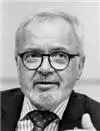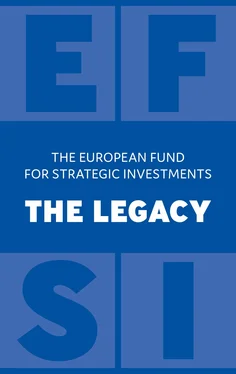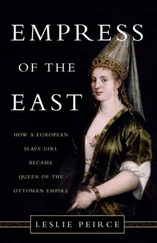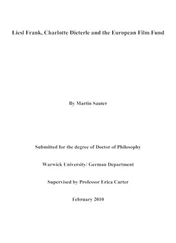Foreword By Werner Hoyer and Jean-Claude Juncker
Introduction
Chapter 1 What is it?
Chapter 2 Did it work?
Chapter 3 Criticisms of EFSI
Chapter 4 Lessons learned
Chapter 5 Legacy
Chapter 6 Flagships
About the European Investment Bank
The European Investment Bank is the world’s biggest multilateral lender. The only bank owned by and representing the interests of the EU countries, the EIB finances Europe’s economic growth. Over six decades the Bank has backed start-ups like Skype and massive schemes like the Øresund Bridge linking Sweden and Denmark. Headquartered in Luxembourg, the EIB Group includes the European Investment Fund, a specialist financer of small and medium-sized enterprises.

THE EUROPEAN FUND FOR STRATEGIC INVESTMENTS
THE LEGACY
The story of the European Fund for Strategic Investments (EFSI) from 2015 to 2020 told through interviews with the Managing Director, Deputy Managing Director, members of the Investment Committee and final beneficiaries across Europe

This publication is based on a series of interviews conducted with the EFSI Managing Director, Deputy Managing Director and members of the Investment Committee. The findings, interpretations and conclusions do not necessarily represent the view of the European Investment Bank or any other institution.
By Werner Hoyer and Jean-Claude Juncker
We met each other back in July 2014 to see what the European Commission—which had just started to prepare for a new five-year mandate—and the European Investment Bank Group could do to counter the economic fallout of the financial crisis. It was clear that business as usual was not an option. No fresh money was available from Member States’ budgets, so we needed a new approach at European level to boost investment, which was still low, even several years after the crisis. Over a working lunch and one weekend of intense work, we came up with the European Fund for Strategic Investments (EFSI), colloquially called the Juncker Plan. The innovative idea—and the great challenge—was to take financial instruments to a new level. We would leverage the impact of this public investment thanks to a European Union guarantee and the robustness of the EIB Group, thus financing the riskier projects that the economy truly needed. This cross-fertilisation between public and private funds is at the heart of EFSI. It is about doing more with less.
The European Fund for Strategic Investments has been one of the good news stories to emerge in a decade of economic uncertainty. It has gone well beyond its highly ambitious target of €500 billion in mobilised investments. The Juncker Plan has made a strong contribution to the 14 million jobs created in the European Union between 2015 and 2020.
EFSI has become a success in co-financing projects that otherwise might not have been carried through. It has also charted the path towards new ways of financing. This is not only the case in relatively conventional areas, such as infrastructure, but also in sectors like research and innovation or the contribution to climate change mitigation. This is exactly what makes EFSI so groundbreaking: responding to the needs of the market through continuous financial innovation.
The principle of EFSI is here to stay. It has paved the way for its successor, the InvestEU programme, which is to be deployed under the 2021-2027 multiannual financial framework.
Today we are proud and grateful. Proud of how EFSI stimulates much-needed investment across Europe, especially from the private sector. Grateful to all the colleagues in the European Commission and the EIB Group who worked tirelessly to make EFSI a success. Our special thanks go to Wilhelm Molterer, managing director, and Iliyana Tsanova, deputy managing director, for their entrepreneurial spirit and remarkable commitment to securing the greatest benefit for the European economy and European citizens.
In this document, we invite you to discover how EFSI came about and how its lean, efficient governance structure, epitomised by the Investment Committee, helped guide it to success. Through the testimony of the leadership behind EFSI, the unveiling of EFSI’s mechanics and the inspiring stories of Europeans whose jobs were created by EFSI, you will learn how the Juncker Plan continues to make a difference, every day.

Werner Hoyer, President, European Investment Bank

Jean-Claude Juncker, Former President, European Commission
How it started
Inside EFSI: The Managing Director
In autumn 2014, Wilhelm Molterer walked from his office on the top floor of the European Investment Bank’s sloping glass headquarters. He entered a meeting room where he joined the EU bank’s president, Werner Hoyer. A former Austrian finance minister, Molterer was one of the Bank’s eight vice-presidents, overseeing its massive operations in the EU Member States and around the world. He wondered what Hoyer intended, particularly when he saw that the meeting room also contained the Bank’s two most important members of staff, Klaus Trömel, head of lending operations, and Secretary General Alfonso Querejeta.
Hoyer told the trio that he had discussed Europe’s economic situation with Jean-Claude Juncker, the former Luxembourg prime minister who was soon to take over as president of the European Commission. Europe had been buffeted by a financial crisis only a few years earlier and the economy was still in trouble. Investment volumes had plummeted during the crisis and remained far below pre-crisis levels. The banking sector had little risk-bearing capacity. Public budgets were squeezed. There were other concerns about the immaturity of European capital markets and inconsistent regulatory environments across the European Union. In response, Juncker had told Hoyer that he needed to send a strong signal that economic recovery was the new Commission’s priority and that it would put the full power of EU institutions behind the task. Hoyer was ready and had proposed ideas of his own about how the European Investment Bank might respond. He wanted to ally the Commission, which manages the EU’s budget, with the financial machinery and expertise of the EIB, the world’s biggest international financial institution.
Still, the plan was going to take the Bank into unknown territory. Molterer and his colleagues wondered at the challenging nature of the project as they began to put together a structure for it. They also aimed for an ambitiously large amount of investment—€315 billion in supported investment over three and a half years, which would later be increased to €500 billion over two additional years, once the programme had started to prove itself. For the EIB, Molterer saw that this programme would mean a shift from output—making big loans to big projects—to impact, in which every euro it loaned would have to trigger an eventual investment totalling €15, when the funds crowded in from other investors were included. It would be investment on the ground that counted.
Читать дальше
















